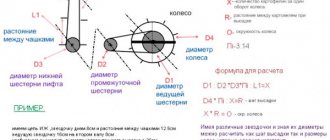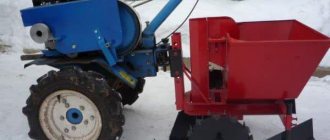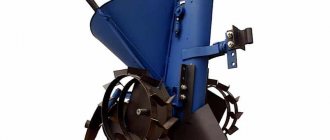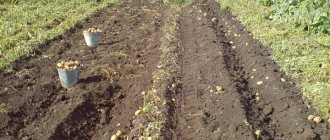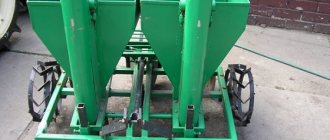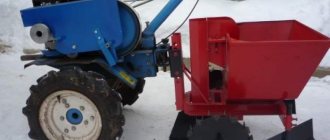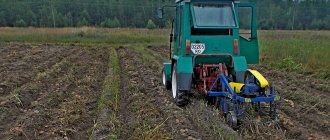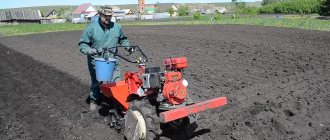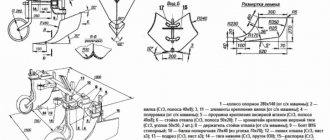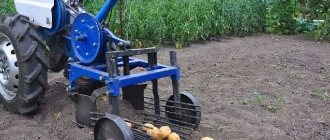What kind of unit is this
The semi-automatic potato planter SN-4B is used for smooth row and ridge planting of potatoes, unless they have previously been germinated. At the same time, mineral fertilizers are automatically applied into the furrow under the tubers.
Planting is done in beds with a distance between ridges of 60 and 70 cm. The distance between tubers in a row can vary from 20 to 40 cm.
The planter can be aggregated with both walk-behind tractors and wheeled tractors MTZ-80, MTZ-82, as well as tracked tractors T-4A, DT-75N.
In this case, the drive of the potato planter chain is carried out from the rear PTO (power take-off shaft) of the tractor. Such equipment is already intended for large-scale potato production.
Here is a detailed diagram of the device in question:
The operation scheme of the potato planter can be described as follows. The unit moves along the furrow following the tractor pulling it. From the tractor power take-off shaft, the torque is transmitted to the planter’s feeding bucket: the spoons of the scooping apparatus engage the tubers and sow them into the furrow at regular intervals.
In addition, immediately before sowing potatoes, bulk fertilizers (usually mineral) are applied into the furrow through a fertilizer pipe. After this, the potatoes are covered with soil from neighboring ridges using the planter coulters.
Reference. The potato planter has a seed tuber hopper with sufficient capacity to sow from 59 to 71 thousand tubers per hectare.
Spare parts
In specialized online stores you can find quite a lot of advertisements regarding the sale of certain spare parts for potato planters. Let's look at a few items that are in particular demand.
The fertilizer tank for the potato planter is designed to directly supply fertilizer to the hole, along with the potato tuber being planted. The capacity of these barrels can be very different - from 5 to 30 liters. Naturally, this directly affects the price that will have to be paid for such a spare part.
For example, the cost of a barrel with a capacity of 30 liters will be about 4 thousand rubles.
For more information about the fertilizer tank for the potato planter, watch the video:
The fertilizer dispenser for the potato planter controls the pouring out of bulk fertilizers from the tank, accurately dispensing the required amount for each hole with potatoes. You can purchase this device for 300-400 rubles, depending on the brand of potato planter.
The potato planter scoop is a small part that grabs the potatoes along a chain and then feeds them into the sloping seed shaft. Depending on the specific model, spoons can be made of plastic or metal.
Naturally, the former are more vulnerable, so they are more likely to be replaced with new ones. The average cost of spoons is low - about 90 rubles per piece.
It is clear that although potato planters have a similar structure, they have several design differences. In particular, certain components and spare parts taken from one unit will almost certainly not fit a potato planter from another line.
Therefore, to make the choice easier, you need to consider the most popular potato planters, as well as those parts that are intended for them.
L 201
The L 201 potato planter is a two-row unit, i.e. At the same time, it is possible to plant tubers in two rows at once, which significantly speeds up the planting process.
- frame structure;
- support-drive wheels;
- planting devices;
- openers;
- groove closures;
- bunker for potato tubers;
- gearbox that changes the landing frequency.
This potato planter is aggregated with tractors of classes 0.6, 0.9 and 1.4.
- row spacing – from 625 to 750 mm;
- container capacity with tubers – 250 kg;
- average speed – up to 10 km/h;
- productivity – up to 1.14 hectares per hour of work;
- the distance between planted tubers is adjustable, from 18 to 37.5 cm;
- total weight – 380 kg;
- unit length – 165 cm;
- unit width – 150 cm;
- unit height – 150 cm.
Spare parts for the L 201 potato planter are widely available in many specialized online stores specializing in the sale of such components. You can make some spare parts yourself, for example, you can make spoons for a potato planter yourself. Among the presented parts, you can find the following items:
- asterisk MNS 02.001 and 02.002 – price from 85 to 95 rubles;
- spoons for potato planter MNS 02.003 – price from 25 rubles per piece;
- hub MNS 02.130 - average price is about 300 rubles;
- opener MNS 05.000 – cost about 1300 rubles;
- drive wheel - MNS 07.000 - price is about 7200 rubles;
- axis MNS 06.060 - average price is about 200 rubles;
- frame COM 01.000 – price is about 6,500 rubles;
- flange COM 02.020 - the estimated price is about 400 rubles;
- chain TRD-38-300-1-2-6-4 - the average price is approximately 6 thousand rubles.
KSM 4
The KSM 4 potato planter is used for planting sprouted and unsprouted potato tubers. Thanks to its design, it can be aggregated with tractors of the 1.4 and 3 series. A distinctive feature of this unit is the presence of a tank for fertilizers, which are planted simultaneously with potatoes.
Components of the KSM 4 potato planter:
- frame structure with trailer;
- two front metal wheels;
- two rear pneumatic wheels;
- main and loading container for potato tubers;
- fertilizer tank;
- rippers;
- drive mechanisms;
- openers;
- fertilizer sowing and planting devices;
- gearboxes.
- row spacing – up to 700 mm;
- container capacity with tubers – 2300 kg;
- average speed – up to 9 km/h;
- productivity - up to 80 thousand tubers per hour of work;
- the distance between planted tubers is adjustable, from 22 to 40 cm;
- total weight – 2350 kg;
- planting depth – up to 16 cm;
- Fertilizer tank capacity – 600 kg.
Specifications
The SN-4B potato planter has the following components that provide it with the specified productivity.
Gearbox
Torque is transmitted to the working parts of the planter from the PTO of the pulling tractor through a gearbox, which has two bevel gears with a number of teeth z=40 and z=14. The driven shaft of the gearbox, through replaceable sprockets with the number of teeth z=22, z=20, z=18 and z=16, as well as a chain transmission, transmits torque to the sprockets of the counter-drive shaft (two pieces: with the number of teeth z=22 and z= 40) and then onto the shaft of the planting devices.
In this case, the sprocket z=22 drives the working parts of the potato planter, in fact, from the PTO, and the sprocket z=40 serves to transmit the torque of the working bodies from an independent PTO. The driven sprocket z=12 of the counter-drive transmits torque to the sprocket z=36 of the right and left shafts of the scooping devices.
Wheels
In the design of the SN-4B potato planter, the wheels serve solely to support and move the unit following the pulling tractor (they are connected to the front frame rail).
Unlike some other models, the wheels of the unit in question are not connected in any way to the control mechanisms of the planter and do not affect the speed and spacing of the tubers. Also, the support wheels are equipped with a mechanism for raising and lowering the potato planter for more efficient operation.
Bunker
Seed material is loaded into the hopper. It is a box welded from thin sheet steel. Its bottom is inclined towards the feeding ladle, it is also equipped with shakers (flaps). In this case, the rear wall of the bunker is made with a window, which is regulated by a damper.
Feeding bucket
The bucket is an integral part of the bunker, which is designed to ensure uninterrupted operation of potato planting devices. The back of the ladle bottom is curved for free release of scooping spoons. In this case, the side walls of the bucket are rigidly connected to the hopper - they fit into the gaps between the scooping spoons and the disk.
In the middle part of the bottom there is a corner divider - it divides the tubers into left and right flow. And for uninterrupted supply of potatoes to the spoons, augers and turners are provided.
As for fertilizers, they are applied by so-called fertilizer sowing devices - through fertilizer pipes and channels. After the substances are in the furrows, special discs cover them with a layer of soil no more than 10 mm thick. And then the tubers lie on this layer of soil.
Device
Judging by the design, the models of potato planters are not much different from each other. In principle, the device itself is quite simple, which can be attached to a walk-behind tractor (see here) or to a mini tractor (see here), so many craftsmen have adapted to making home-made units (more details here) that have exactly the same principle of operation.
Device
Structurally, the potato planter looks like this:
- frame structure on which other elements of the device are located;
- container in which the planting potatoes are located;
- a mechanism for planting potato tubers, which is driven by gears;
- rippers that form holes;
- disk elements that fill the holes after planting tubers in them;
- wheelbase.
This is a fairly typical list of what is included in a potato planter. Depending on the configuration, the design can be supplemented with a tank and a fertilizer dispenser, as well as an additional hopper for planting potatoes (you can read more about such a device as a potato planter for a walk-behind tractor here).
If you are interested in chainsaws, then you will be interested in reading about Russian-made chainsaws.
One of the most popular Russian chainsaws is the Druzhba chainsaw. You can read about it in one of our articles.
Also from our articles you will learn about the Lesnik chainsaw, also made in Russia.
Operating rules
To configure the operation of the SN-4B potato planter, the operating speed is initially selected. This is done according to the corresponding table of standards.
Eg:
- when working with a pulling tractor MTZ-80 in second gear, providing a speed of 6 to 7 km/h, and also with the sprocket z=20 installed, from 59 to 71 thousand tubers are planted per 1 hectare;
- when working with an asterisk z=18, the number of tubers ranges from 42 to 47 thousand;
- when working with an asterisk z=16, the number of tubers ranges from 35 to 41 thousand.
The PTO ensures that the drive performance depends on the speed of rotation of the axles of the tractor's drive wheels. Therefore, the distance between the sown tubers does not depend on the speed of the potato planter. The PTO makes 3.5 revolutions per linear meter of the unit’s trajectory. However, an undesigned, that is, too high speed of movement of equipment increases the risk of missed areas for planting tubers and their damage. High planting speed is harmful to seed material.
A replacement sprocket is selected based on trial runs. To do this, it is necessary that the potato planter travels at least 8-10 m. If the distance between the ridges of the rows is 70 cm, count the number of planted tubers over a length of 7.14 m. In area this will be 5 square meters. m. Next, the resulting amount is multiplied by 2000 - this will be the number of potatoes required for sowing per hectare. If the obtained value does not fall within the standard range, then the sprocket on the gearbox shaft is replaced.
Important. The potato planter must move at the designed speed.
Planters KORA
The equipment is produced by the German manufacturer UNIA. The company offers a range of planters in four-row and two-row versions:
- KORA-2 bunker for 400 kg, row spacing 70-75 cm
- KORA-4 bunker 840 kg, row spacing 75 -90 cm
- KORA-4H with a hydraulic lifting hopper for 1000 kg, row spacing 75 cm
- KORA-4HP hydropowered bunker capacity 2000 kg, row spacing 75 cm
Models are segmented by level of additional equipment and may differ in their design:
- bunker volume
- the presence of a hydraulic lift of the bunker
- stage for the operator
- equipped with a mechanism for automatically adjusting the embedment depth
The machines have twin escalator-type planting devices based on a rubber conveyor driven by support running wheels.
In addition to the models described above, the following manufacturers of four-row planters are on the market:
- Planters of the Grammer and Nassia brands made in the Netherlands.
- Cars of the brands Bomet and POLO 4H made in Poland.
- Machines L-202, L-207 manufactured in Russia: hopper 600 kg, row spacing 70 cm, loading height 450 mm, operating speed 4-10 km/h, productivity 1.26-2.4 ha/hour.
- Planting complexes SK-4 produced in Belarus.
Where to buy and how much it costs
Semi-automatic potato planters SN-4B are widely used in medium-sized agricultural enterprises. Plus, their models with various improvements are manufactured by many agricultural engineering factories. You can purchase such planters either new or used.
Their prices are in the range:
- new ones - from 220 to 420 thousand rubles;
- used – from 40 to 180 thousand rubles.
Advantages and disadvantages
Let's start with the advantages:
- SN-4B has a very laconic design, which compares favorably with complex imported units that are similar in functionality. This means relative ease of installation and availability of spare parts.
- The potato planters under consideration are lightweight (no more than 1.1 tons without loading), which ensures low specific pressure on the ground.
- Potato planters SN-4B provide high productivity, as they are able to work at the second speed of the tractor (up to 7 km/h).
- Affordable (compared to imported analogues) price.
However, there are also disadvantages:
- Low reliability of the design, which entails frequent failure of components and parts.
- The main material for the manufacture of the potato planters under consideration is carbon and alloy steel (not stainless steel), as a result of which the unit is subject to intense corrosion when stored in an unheated room.
Types of potato planters
Potato planters for walk-behind tractors differ in the following characteristics .
By the number of processed rows
The units are divided into one and two rows . Naturally, a double-row planter must have a more powerful engine: if an engine of 6 liters is enough for a single-row planter. With. (like, for example, the Neva walk-behind tractor - 6.5 hp), then the two-row unit must have a power of at least 9 hp. With. (like, for example, the Belarus-09N walk-behind tractor). A double-row block is, of course, potentially more productive, but its processing speed is approximately 1.5 times lower than that of a single-row block. In addition, it requires higher operator qualifications.
Depending on the manufacturer
These devices are produced by many Russian and Belarusian machine-building enterprises , not even necessarily specialized ones (for example, as part of conversion). The domestic models KS-1, KS-1A, KSM-1, KTS-2 and KTS-4 for one, two or four rows, respectively, deserve attention.
Reference. The pattern is simple: domestic and Belarusian equipment costs several times less than imported equipment.
By type of technological process
For low-power potato planters, planting potatoes is divided into two stages:
- First, the tubers are laid out in furrows;
- During the second pass, the unit covers the furrow with earth.
For potato planters with stronger engines, this process can be combined : the unit immediately lays out the tubers and covers them with soil in one pass.
Interesting things on the site:
User reviews
The most objective characteristics of the quality of the SN-4B potato planter are provided by its users. Let's evaluate some of them:
Victor, Balakovo: “ If you have a YuMZ, MTZ 50, 80 and higher tractor, then you can use it... It doesn’t like heavy soils - it “lifts” it on them.” It does not like clogged soil - the coulter becomes clogged and the support wheel jams. Small bunker - needs to be expanded. If the paddock is short, you can work; if it’s long, then you have to reboot. And since the potato planter is quite heavy, it is advisable to improve the ratio of weight and useful loading of the bunkers by modifying the model yourself.”
Evgeny, Tambov: “There are practically no gaps if there are normal springs on the pressure fingers. He doesn’t really like cut potatoes, but if the potatoes are sprouted with eyes up to 0.7 cm, then they plant better. If the sprouted one is larger, it breaks the sprouts.”
Denis, Volzhsk: “Four tons per 1 hectare at the third slow speed - the sowing distance will be approximately 15 cm, the seed size will be the size of a chicken egg. A trifle in the second direct drive, and accordingly, the consumption is higher. Another point: keep the speed in the range of 1500-1700, with a dependent PTO of 540; if it’s faster, there will be misfires. The seeding rate can be adjusted not by removing the “feet”, but simply by inserting another gear. When we bought the planter, we immediately calibrated it, in which gear to plant how much, and the plantings also need some finishing touches.”
This is interesting:
How to make a potato planter for a mini tractor with your own hands.
Step-by-step instructions for creating a homemade potato planter.
What are the advantages of manual potato peelers?
How to make a potato planter for a walk-behind tractor with your own hands
You can build a device for a walk-behind tractor yourself . Let's take a closer look at what is required for this, and also draw up a technological map.
Required materials and tools
For installation you will need:
- channel or angle for a welded frame;
- metal wheels-hooks (it is better to purchase ready-made ones);
- an axis for attaching hooks to it;
- set of bearings;
- steel sheets for a welded bunker (steel thickness - from 1.5 to 2 mm);
- sprockets (19-21 teeth);
- chain from the gas distribution mechanism of the internal combustion engine;
- steel wire (3-4 mm).
Tools required:
- Bulgarian;
- welding machine (semi-automatic is sufficient);
- drill (more powerful);
- compressor and spray gun.
For greater specificity, let the model of the proposed potato planter have the following dimensions :
- frame – 600×300 mm;
- hook diameter – 300-310 mm;
- track (distance between the centers of the hooks) – 600 mm;
- seed tube chain length – 750 mm;
- the distance between the axes of the sprockets holding the seed tube chain is 550 mm;
- bunker – 350×400×400 mm;
- four standard 205 size bearings.
Summary
The potato planter SN-4B is a productive agricultural unit, quite technologically advanced and in terms of complexity fully consistent with its purpose.
It is easy to calibrate, adjust and repair, which is extremely important for field conditions. But the main advantage is the performance indicator of the SN-4B in relation to its cost. According to the latter parameter, similar equipment produced in the territory of the former Soviet Union still remains uncompetitive, mainly due to its low price.
Planting potatoes with a CH 4 machine
Spare parts for potato planters - necessary for high-quality work
The potato planter is an auxiliary device.
Its use greatly simplifies the process of planting potatoes, which makes this device indispensable, especially when working in very large areas. However, direct contact with the ground may affect individual parts of the device. Very often there are cases when some component of the system fails, without which further operation is impossible.
Fortunately, purchasing the necessary part and installing it in the device is not difficult. To make it easier to understand the essence of the problem, you need to consider in more detail not only the components, but also the device of the potato planter itself as a whole.
